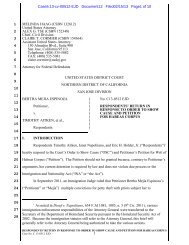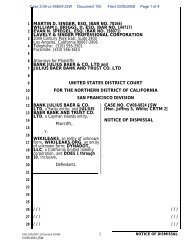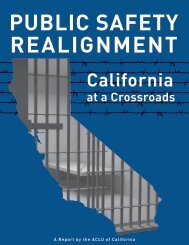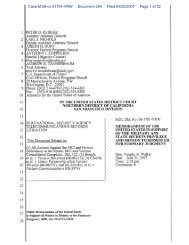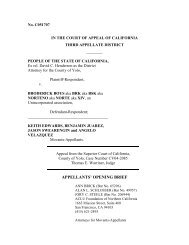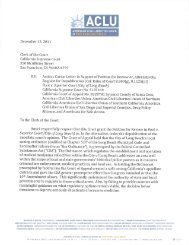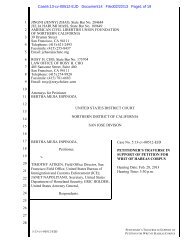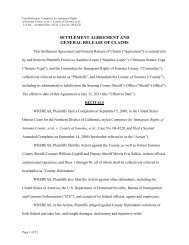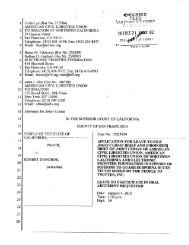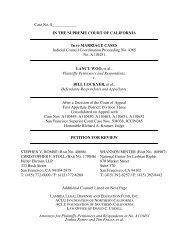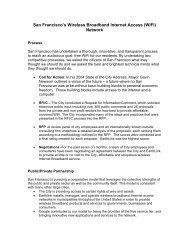Stun Gun Fallacy - ACLU of Northern California
Stun Gun Fallacy - ACLU of Northern California
Stun Gun Fallacy - ACLU of Northern California
You also want an ePaper? Increase the reach of your titles
YUMPU automatically turns print PDFs into web optimized ePapers that Google loves.
Appendix A<br />
Scope and Methodology<br />
On May 16, 2005, the <strong>ACLU</strong> <strong>of</strong> <strong>Northern</strong> <strong>California</strong> sent<br />
Public Records Act requests to several police and sheriff<br />
departments throughout <strong>Northern</strong> and Central <strong>California</strong>.<br />
The requests were sent to every department that employs 100<br />
or more sworn <strong>of</strong>ficers as well as departments that we knew or<br />
believed from news reports used Tasers. At the beginning <strong>of</strong><br />
June, we sent another round to a few smaller agencies. In total,<br />
requests were sent to 79 agencies.<br />
Between May and August, we received documents from the<br />
agencies. We reviewed their policy documents and the training<br />
materials that were provided. If departments did not respond,<br />
we followed up multiple times.<br />
One agency, the Oakland Police Department, was good<br />
enough to invite us to attend the full Taser training presented<br />
to their <strong>of</strong>ficers. This experience was extremely informative<br />
and rewarding and we thank the Oakland Police Department<br />
for their openness.<br />
The information we have reported in this report is based on<br />
information we received when we received it. Some departments<br />
may have changed their policies and training in the interim.<br />
We did not do additional follow-up requests after we<br />
received a response. Departments that reported at the time<br />
they did not use Tasers may have since employed them. Other<br />
agencies may have modified their training materials or policies.<br />
The information contained in this report represents the state <strong>of</strong><br />
Taser training and policy at the time we issued the request. •<br />
Appendix B<br />
Best Practices Taser Policy<br />
Taken from law enforcement agencies throughout northern<br />
and central <strong>California</strong>. This does not necessarily<br />
represent the <strong>ACLU</strong>-NC’s “model policy,” however it<br />
represents some <strong>of</strong> the best policies currently being employed<br />
by regional law enforcement agencies.<br />
Purpose:<br />
To establish guidelines for the deployment and use <strong>of</strong> the<br />
Taser.<br />
Policy Statement:<br />
To deploy and use the Taser in a manner which maximizes the<br />
safety <strong>of</strong> all individuals involved in an incident.<br />
(Capitola Police Department Departmental Order No. 60)<br />
Procedure:<br />
I. GENERAL CONSIDERATIONS<br />
A. Definition: The X26 Air Taser is a conducted energy<br />
weapon that utilizes compressed nitrogen to shoot<br />
two probes up to twenty-one feet. The probes are connected<br />
to the weapon by high-voltage insulated wires.<br />
When the probes make contact with the target, the<br />
Taser transmits electrical pulses along the wires and<br />
into the body <strong>of</strong> the target. The X-26 Taser has a builtin<br />
memory to track usage. It has the ability to download<br />
information relating to the time discharged, time<br />
<strong>of</strong> the day and duration <strong>of</strong> the discharge. (Gilroy Police<br />
Department, Addendum to GPD Policy Manual<br />
Section 308, June 2004)<br />
B. Less-Lethal Weapon: As with other “less-lethal”<br />
force options, this department is committed to reducing<br />
the potential for violent confrontations with the<br />
suspects we encounter. The X26 Advanced Taser technology<br />
is one <strong>of</strong> those items, which when used properly,<br />
are less likely to result in serious physical injury<br />
or death. (Gilroy Police Department, Addendum to<br />
GPD Policy Manual Section 308, June 2004)<br />
Although designed to lower the risk to <strong>of</strong>ficers and<br />
civilians, and not cause serious injury or death, it is<br />
recognized that any less-lethal force weapon has the<br />
potential to cause serious injury or death. (Redding<br />
Police Department, General Order A-43.2 Less Lethal<br />
Force Weapons)<br />
C. Training: The Taser shall only be used by <strong>of</strong>ficers and<br />
supervisors trained in its deployment and use. Officers<br />
shall use the Taser in a manner that is consistent with<br />
departmental orders and training guidelines. (Capitola<br />
Police Department Departmental Order No. 60)<br />
<strong>Stun</strong> <strong>Gun</strong> <strong>Fallacy</strong> 17



